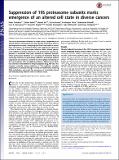Suppression of 19S proteasome subunits marks emergence of an altered cell state in diverse cancers
Author(s)
Tsvetkov, Peter; Brune, Zarina; Thiru, Prathapan; Ghandi, Mahmoud; Santagata, Sandro; Whitesell, Luke; Sokol, Ethan Samuel; Jin, Dexter X.; Gupta, Piyush; Lindquist, Susan; Garraway, Levi A.; ... Show more Show less
DownloadTsvetkov-2016-Suppression of 19S proteasome su.pdf (1.217Mb)
PUBLISHER_POLICY
Publisher Policy
Article is made available in accordance with the publisher's policy and may be subject to US copyright law. Please refer to the publisher's site for terms of use.
Terms of use
Metadata
Show full item recordAbstract
The use of proteasome inhibitors to target cancer’s dependence on altered protein homeostasis has been greatly limited by intrinsic and acquired resistance. Analyzing data from thousands of cancer lines and tumors, we find that those with suppressed expression of one or more 19S proteasome subunits show intrinsic proteasome inhibitor resistance. Moreover, such proteasome subunit suppression is associated with poor outcome in myeloma patients, where proteasome inhibitors are a mainstay of treatment. Beyond conferring resistance to proteasome inhibitors, proteasome subunit suppression also serves as a sentinel of a more global remodeling of the transcriptome. This remodeling produces a distinct gene signature and new vulnerabilities to the proapoptotic drug, ABT-263. This frequent, naturally arising imbalance in 19S regulatory complex composition is achieved through a variety of mechanisms, including DNA methylation, and marks the emergence of a heritably altered and therapeutically relevant state in diverse cancers.
Date issued
2016-12Department
Broad Institute of MIT and Harvard; Massachusetts Institute of Technology. Department of Biology; Koch Institute for Integrative Cancer Research at MITJournal
Proceedings of the National Academy of Sciences
Publisher
National Academy of Sciences (U.S.)
Citation
Tsvetkov, Peter et al. “Suppression of 19S Proteasome Subunits Marks Emergence of an Altered Cell State in Diverse Cancers.” Proceedings of the National Academy of Sciences 114, 2 (Janaury 2017): 382–387 © 2017 National Academy of Sciences
Version: Final published version
ISSN
0027-8424
1091-6490